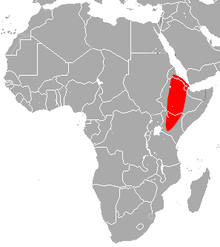Ethiopian large-eared roundleaf bat
| Ethiopian large-eared roundleaf bat | |
|---|---|
| Scientific classification | |
| Kingdom: | |
| Phylum: | |
| Class: | |
| Order: | |
| Family: | |
| Genus: | |
| Species: | H. megalotis
|
| Binomial name | |
| Hipposideros megalotis (Heuglin, 1862)
| |

| |
| Ethiopian large-eared roundleaf bat range | |
| Synonyms | |
| |
The Ethiopian large-eared roundleaf bat (Hipposideros megalotis) is a species of bat in the family Hipposideridae. It is found in Djibouti, Eritrea, Ethiopia, Kenya, Saudi Arabia, and Somalia. Its natural habitats are dry savanna, subtropical or tropical dry shrubland, caves, and hot deserts. It is threatened by habitat loss.
Taxonomy and etymology
It was described as a new species in 1862 by German ornithologist Theodor von Heuglin. Von Heuglin placed it in the now-defunct genus Phyllorrhina (misspelling of Phyllorhina), with a scientific name of Phyllorrhina megalotis.[2] Its species name "megalotis" means "long-eared."
Biology
It is nocturnal, roosting in sheltered places during the day such as man-made structures. It also possibly uses caves for roosts.[1]
Range and habitat
It has been found in Djibouti, Eritrea, Ethiopia, Kenya, and Saudi Arabia. It has been found at elevations up to 2,000 m (6,600 ft).[1]
Conservation
It is currently assessed as least concern by the IUCN—its lowest conservation priority. It meets the criteria for this designation because it has a large geographic range; it is found in a variety of habitats; and it is not thought to be in rapid decline.[1]
References
- ^ a b c d Monadjem, A.; Fahr, J.; Hutson, A.M.; Mickleburgh, S.; Bergmans, W. (2017). "Hipposideros megalotis". The IUCN Red List of Threatened Species. 2017. IUCN: e.T10150A22101286. doi:10.2305/IUCN.UK.2017-2.RLTS.T10150A22101286.en. Retrieved 5 December 2017.
{{cite journal}}: Unknown parameter|last-author-amp=ignored (|name-list-style=suggested) (help) - ^ von Heuglin, Theodor (1861). "Beiträge zur Fauna der Säugethiere N.O.-Afrikas". Novorum actorum Academiae Caesareae Leopoldino-Carolinae Germanicae Naturae Curiosorum. 29 (8): 8–10.

